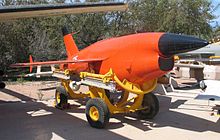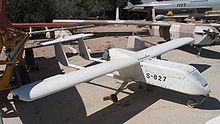An unmanned aerial vehicle (UAV),
commonly known as a drone, as an unmanned aircraft system (UAS), or by several other names, is an aircraft without a human pilot aboard. The flight of UAVs may operate with various degrees of autonomy: either under remote control by a human operator, or fully or intermittently autonomously, by onboard computers. Compared to manned aircraft, UAVs are often preferred for missions that are too "dull, dirty or dangerous" for humans. They originated mostly in military applications, although their use is expanding in commercial, scientific, recreational and other applications, such as policing and surveillance, aerial photography, agriculture and drone racing. Civilian drones now vastly outnumber military drones, with estimates of over a million sold by 2015.

Terminology
Multiple terms are used for unmanned aerial vehicles, which generally refer to the same concept.
The term drone, more widely used by the public, was coined in reference to the resemblance of dumb-looking navigation and loud-and-regular motor sounds of old military unmanned aircraft to the male bee. The term has encountered strong opposition from aviation professionals and government regulators. The term unmanned aircraft system (UAS) was adopted by the United States Department of Defense (DoD) and the United States Federal Aviation Administration in 2005 according to their Unmanned Aircraft System Roadmap 2005–2030. The International Civil Aviation Organization (ICAO) and the British Civil Aviation Authority adopted this term, also used in the European Union's Single-European-Sky (SES) Air-Traffic-Management (ATM) Research (SESAR Joint Undertaking) roadmap for 2020. This term emphasizes the importance of elements other than the aircraft. It includes elements such as ground control stations, data links and other support equipment. A similar term is anunmanned-aircraft vehicle system (UAVS) remotely piloted aerial vehicle (RPAV), remotely piloted aircraft system (RPAS). Many similar terms are in use.
A UAV is defined as a "powered, aerial vehicle that does not carry a human operator, uses aerodynamic forces to provide vehicle lift, can fly autonomously or be piloted remotely, can be expendable or recoverable, and can carry a lethal or nonlethal payload". Therefore, missiles are not considered UAVs because the vehicle itself is a weapon that is not reused, though it is also unmanned and in some cases remotely guided.The relation of UAVs to remote controlled model aircraft is unclear. UAVs may or may not include model aircraft. Some jurisdictions base their definition on size or weight, however, the US Federal Aviation Administration defines any unmanned flying craft as a UAV regardless of size. A radio-controlled aircraft becomes a drone with the addition of an autopilot artificial intelligence (AI), and ceases to be a drone when the AI is removed.
History Main
 In 1849 Austria sent unmanned, bomb-filled balloons to attack Venice.[9] UAV innovations started in the early 1900s and originally focused on providing practice targets for training military personnel. UAV development continued during World War I, when the Dayton-Wright Airplane Company invented a pilotless aerial torpedo that would explode at a preset time.
In 1849 Austria sent unmanned, bomb-filled balloons to attack Venice.[9] UAV innovations started in the early 1900s and originally focused on providing practice targets for training military personnel. UAV development continued during World War I, when the Dayton-Wright Airplane Company invented a pilotless aerial torpedo that would explode at a preset time.
The earliest attempt at a powered UAV was A. M. Low's "Aerial Target" in 1916. Nikola Tesla described a fleet of unmanned aerial combat vehicles in 1915. Advances followed during and after World War I, including the Hewitt-Sperry Automatic Airplane. The first scaled remote piloted vehicle was developed by film star and model-airplane enthusiast Reginald Denny in 1935.[11] More emerged duringWorld War II – used both to train antiaircraft gunners and to fly attack missions. Nazi Germany produced and used various UAV aircraft during the war. Jet engines entered service after World War II in vehicles such as the Australian GAF Jindivik, and Teledyne Ryan Firebee I of 1951, while companies like Beechcraft offered their Model 1001 for the U.S. Navy in 1955. Nevertheless, they were little more than remote-controlled airplanes until the Vietnam War.
In 1959, the U.S. Air Force, concerned about losing pilots over hostile territory, began planning for the use of unmanned aircraft. Planning intensified after the Soviet Unionshot down a U-2 in 1960. Within days, a highly classified UAV program started under the code name of "Red Wagon". The August 1964 clash in the Tonkin Gulf between naval units of the U.S. and North Vietnamese Navy initiated America's highly classified UAVs (Ryan Model 147, Ryan AQM-91 Firefly, Lockheed D-21) into their first combat missions of the Vietnam War. When the Chinese government showed photographs of downed U.S. UAVs via Wide World Photos, the official U.S. response was "no comment".
The War of Attrition (1967-1970) featured the introduction of UAVs with reconnaissance cameras into combat in the Middle East.
In the 1973 Yom Kippur War Israel used drones as decoys to spur opposing forces into wasting expensive anti-aircraft missiles.
The Israeli Tadiran Mastiff, which first flew in 1973, is seen by many as the first modern battlefield UAV, due to its data-link system, endurance-loitering, and live video-streaming.
In 1973 the U.S. military officially confirmed that they had been using UAVs in Southeast Asia (Vietnam). Over 5,000 U.S. airmen had been killed and over 1,000 more were missing or captured. The USAF 100th Strategic Reconnaissance Wing flew about 3,435 UAV missions during the war at a cost of about 554 UAVs lost to all causes. In the words of USAF General George S. Brown, Commander,Air Force Systems Command, in 1972, "The only reason we need (UAVs) is that we don't want to needlessly expend the man in the cockpit." Later that year, General John C. Meyer, Commander in Chief, Strategic Air Command, stated, "we let the drone do the high-risk flying ... the loss rate is high, but we are willing to risk more of them ... they save lives!"
During the 1973 Yom Kippur War, Soviet-supplied surface-to-air missile batteries in Egypt and Syria caused heavy damage to Israelifighter jets. As a result, Israel developed the first UAV with real-time surveillance. The images and radar decoys provided by these UAVs helped Israel to completely neutralize the Syrian air defenses at the start of the 1982 Lebanon War, resulting in no pilots downed.The first time UAVs were used as proof-of-concept of super-agility post-stall controlled flight in combat-flight simulations involved tailless, stealth technology-based, three-dimensional thrust vectoring flight control, jet-steering UAVs in Israel in 1987.
With the maturing and miniaturization of applicable technologies in the 1980s and 1990s, interest in UAVs grew within the higher echelons of the U.S. military. In the 1990s, the U.S. DoD gave a contract to AAI Corporation along with Israeli company Malat. The U.S. Navy bought the AAI Pioneer UAV that AAI and Malat developed jointly. Many of these UAVs saw service in the 1991 Gulf War. UAVs demonstrated the possibility of cheaper, more capable fighting machines, deployable without risk to aircrews. Initial generations primarily involved surveillance aircraft, but some carried armaments, such as the General Atomics MQ-1 Predator, that launched AGM-114 Hellfire air-to-ground missiles.
CAPECON was a European Union project to develop UAVs, running from 1 May 2002 to 31 December 2005.
As of 2012, the USAF employed 7,494 UAVs – almost one in three USAF aircraft. The Central Intelligence Agency also operated UAVs.
In 2013 at least 50 countries used UAVs. China, Iran, Israel and others designed and built their own varieties.
 In 1849 Austria sent unmanned, bomb-filled balloons to attack Venice.[9] UAV innovations started in the early 1900s and originally focused on providing practice targets for training military personnel. UAV development continued during World War I, when the Dayton-Wright Airplane Company invented a pilotless aerial torpedo that would explode at a preset time.
In 1849 Austria sent unmanned, bomb-filled balloons to attack Venice.[9] UAV innovations started in the early 1900s and originally focused on providing practice targets for training military personnel. UAV development continued during World War I, when the Dayton-Wright Airplane Company invented a pilotless aerial torpedo that would explode at a preset time. The Israeli Tadiran Mastiff, which first flew in 1973, is seen by many as the first modern battlefield UAV, due to its data-link system, endurance-loitering, and live video-streaming.
The Israeli Tadiran Mastiff, which first flew in 1973, is seen by many as the first modern battlefield UAV, due to its data-link system, endurance-loitering, and live video-streaming. 


No comments:
Post a Comment